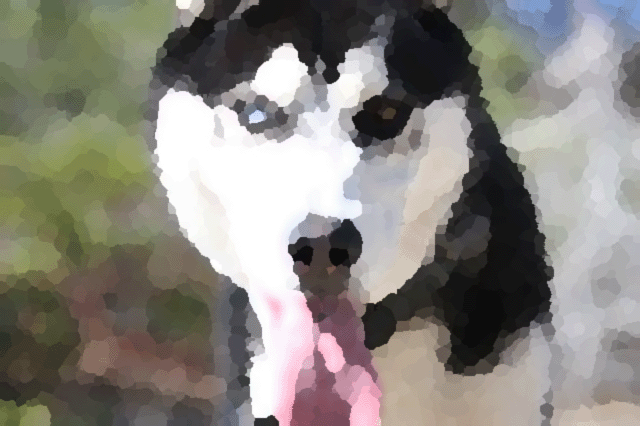|

| |
X-Back Harnesses
The neck opening will look a little
snug at times. Here's a good
way to check for proper harness fit around the neck: After you've
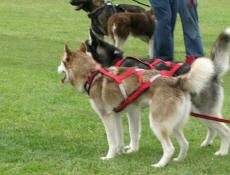 put the harness on your dog,
make sure to fit the neck portion properly around his neck and shoulder area
by getting the fur (and collar) out of the way. Then grab the tug portion of
the harness (the tug is the loop at the end of the harness where you would
attach the scooter line/tugline to) and have your dog push forward against
the harness (basically, have him LINE OUT!). While he is holding this
position, check the front of the harness collar. The webbing for the neck
portion will converge with the webbing that goes in put the harness on your dog,
make sure to fit the neck portion properly around his neck and shoulder area
by getting the fur (and collar) out of the way. Then grab the tug portion of
the harness (the tug is the loop at the end of the harness where you would
attach the scooter line/tugline to) and have your dog push forward against
the harness (basically, have him LINE OUT!). While he is holding this
position, check the front of the harness collar. The webbing for the neck
portion will converge with the webbing that goes in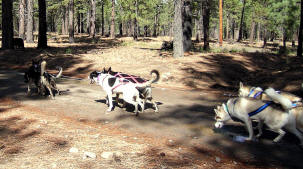 between the dog's front legs. This intersection forms a "Y" and if you press
against it (again, make sure your dog is pushing forward on his harness),
this should be firmly hitting his breastbone. Note: if the "Y" portion
is pressing up above his breastbone, then the neck opening is too small and
will choke your dog when he pushes against it. If the "Y" portion presses
below the breastbone, then the neck opening is too big and the webbing
will
between the dog's front legs. This intersection forms a "Y" and if you press
against it (again, make sure your dog is pushing forward on his harness),
this should be firmly hitting his breastbone. Note: if the "Y" portion
is pressing up above his breastbone, then the neck opening is too small and
will choke your dog when he pushes against it. If the "Y" portion presses
below the breastbone, then the neck opening is too big and the webbing
will 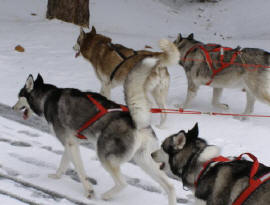 be getting in the way of
the dog's shoulder movements. An additional area to check as far as
proper harness neck sizing is the "X" or diamond webbing portion that forms
at the top of the collar. With your dog pushing forward against his harness,
this diamond portion of the webbing should be positioned in between his
shoulder blades. And while we are on the subject of proper harness
fit, might as well check to see if the harness is the proper length. Once
again, have your dog push against the harness (or be getting in the way of
the dog's shoulder movements. An additional area to check as far as
proper harness neck sizing is the "X" or diamond webbing portion that forms
at the top of the collar. With your dog pushing forward against his harness,
this diamond portion of the webbing should be positioned in between his
shoulder blades. And while we are on the subject of proper harness
fit, might as well check to see if the harness is the proper length. Once
again, have your dog push against the harness (or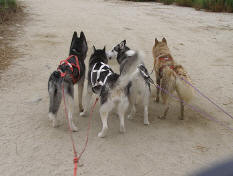 you can pull on it) while holding the tug portion. The end of the webbing
(not the rope tug) should be a the base of the tail (where the tail connects
to your dog's torso). If the harness length is too long, then the harness
will be squeezing your dog's hips. If the harness is too short, then it
could be pushing against his ribs.
you can pull on it) while holding the tug portion. The end of the webbing
(not the rope tug) should be a the base of the tail (where the tail connects
to your dog's torso). If the harness length is too long, then the harness
will be squeezing your dog's hips. If the harness is too short, then it
could be pushing against his ribs. |
| |
| |
|
